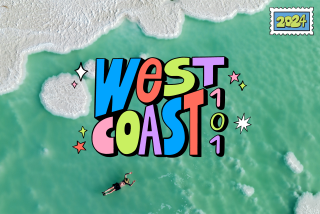Where on Earth Are We?
- Share via
True, the National Geographic Society has a real stake in geography. Also foldout maps and lush color photos of wet woodlands, wild creatures and tribal women around campfires. But this week, the society made a stunning point with new numbers from its geography quiz of young people in nine industrialized nations. Turns out, those surveyed are mostly geography dummies. The good news: Americans ages 18 to 24 are not the dumbest. The bad news: Only one other nation scored lower (the one just south of California).
The society hired Roper Surveys to ask 56 questions of 3,250 young adults last summer in Sweden, Germany, Italy, France, Japan, Britain, Canada, the United States and Mexico. Nearly 30% of these folks could not find the Pacific Ocean. The location of India, home to 17% of the world’s population, eluded 56%.
Americans often appear to savor how insular they can seem compared with a multilingual world. (Eighty-nine percent of the Swedes are at least bilingual.) And there are plenty of data to support that. Respondents in every other land had a more accurate idea of U.S. population than did American young people, a third of whom put the total upward of 2 billion. Judging by movie lines perhaps. Only 56% of the Americans could locate California and Texas; 51% found New York but only 30% placed New Jersey. Maybe the weather. However, 34% of the Americans did know where last season’s “Survivor” show was filmed (South Pacific). It’s no shock to 100% of parents that kids are adept at tuning out information they do not think they need, even though they tune it out before they decide they don’t need it.
On average, the Americans got 41% of the questions correct; the Swedes, the best, averaged 71%. A majority of Americans knew that Al Qaeda and the Taliban were in Afghanistan but only 17% knew where that land was, and only one in seven could place a country called Iraq. On the results’ plus side, fully 89% of U.S. respondents could find the United States on a world map (gee, thanks); on the minus side, 95% of the Canadians could find the U.S. (oops).
The society appointed a task force to study improving humanity’s geography sense. Schools could stop cutting geography lessons because they’re not stressed on state tests. Parents could keep an atlas TV-handy to pounce, in pedant mode, at the mention of any country. Of course, one obvious solution would be for every living soul to subscribe to National Geographic. We’d have better- informed kids, though fewer forests to photograph.
More to Read
Sign up for Essential California
The most important California stories and recommendations in your inbox every morning.
You may occasionally receive promotional content from the Los Angeles Times.









